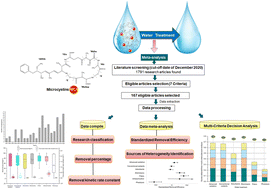A quantitative analysis of drinking water treatments for the removal of dissolved microcystins†
Abstract
Microcystins produced by toxic cyanobacterial blooms are a growing threat to water quality because microcystin-contaminated water is unsafe for human consumption and other activities. To protect public health, various physicochemical methods were developed to remove these toxins from surface and drinking water. However, it is difficult to compare microcystin removal efficacy by various water treatments because removal efficiencies depend on operating conditions, which are unique to each water treatment facility. Thus, we used quantitative meta-analysis to assess the microcystin removal efficiency from water by considering 46 water treatment methods described in 167 eligible published articles from 2000 to 2020. The 46 water treatment methods were divided into 7 technologies based on the reactive material properties and reactions. The removal effectiveness (i.e., removal efficiency and kinetic rate) of 6 common microcystin congeners was evaluated in pure water (control) and natural water. The mean initial concentration of microcystins was heterogeneous among water treatments, which decided the effectiveness of microcystin removal technology. All technologies showed apparent heterogeneity, and sources of variation (i.e., water matrices and microcystin congeners) were identified. A multi-criteria decision analysis of the potential microcystin removal from water with the 7 technologies obtained technology scores that were higher for advanced oxidation (0.68) = electrolysis (0.68) > conventional oxidants (0.67) > adsorbents (0.5) > filters (0.34) > photolysis (0.21). Water treatment with advanced oxidation processes, conventional oxidants, and adsorbent-based materials combined with filtration are the most effective options for removing microcystins from water. However, this depends upon the water matrix and microcystin variants present, which will affect the sustainability and economic viability of these treatment options. Our study provides a robust global assessment of microcystin removal by various water treatments, the first step in choosing effective treatments that eliminate microcystins from water and protect public health.



 Please wait while we load your content...
Please wait while we load your content...